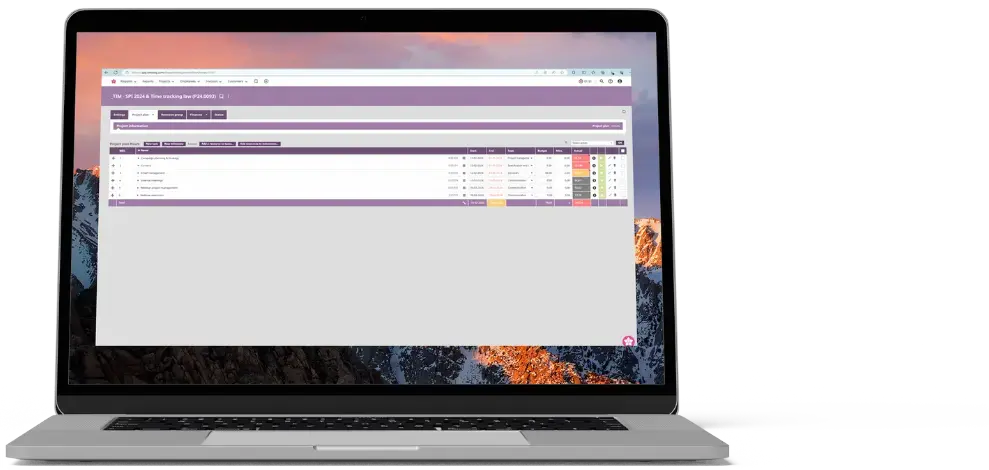Ready to take your project profitability to the next level?
13 min read
Time tracking
Build your perfect data foundation for spotless invoicing and deep business insights with easy time tracking.
Project management
Be a world champion project manager. Keep your projects on track - and profitable.
Resource management
Efficiently staff projects and run a predictable business with confidence.
Insights & Reporting
Get smarter - faster - to make clever decisions for long-term growth impact.
Project accounting & Invoicing
Invoice everything - fast and accurate - while staying on top of project finances.
Staff & Salary
Give accountants and HR an intelligent tool to eliminate draining administration.
Financial Systems
TimeLog offers standard integrations for all your favourite financial systems. Save time and reduce manual tasks.
Payroll Solutions
TimeLog offers standard integrations for multiple payroll solutions. Get easy salary administration and only enter payroll information once.
Add-ons
Track time automatically via Outlook, use gamification or find another add-on that can support your business.
Multiple Legal Entities
You can create synergy between your departments and across borders and offices with the Multiple Legal Entities module from TimeLog.
Business Intelligence
Utilise the insights you get from TimeLog to the fullest. Our system is ready to integrate with multiple BI solutions.
Partner Integrations
TimeLog PSA is part of a large ecosystem. Get an overview of all the partner integrations in the TimeLog family.
Economy department
Save 1-2 days a month on your invoicing process.
Project teams
From planning to execution and evaluation. Robust tools for every project manager.
Management teams
Create a performance-driven culture with solid reporting capabilities.
Large enterprises
Enhance operations and performance across entities, countries and departments.
NGOs and non-profit organisations
Simplify internal processes, spend less time on administration, and get documentation in place - at a discounted rate.
Blog
Get inspired to run an even better business with articles, guides and analyses.
Guides, podcasts and webinars
Get access to templates, guides and webinars that help and inspire you.
Help Center
Looking for help material and user guides to the TimeLog system? Look no further. Find all the help you need now.
Get a single source of truth
Discover how companies maintain a single source of truth across borders, departments, and currencies.
Get integrated
Discover the advantages customers gain from utilising our integrations and API.
Reporting in real-time
Explore how others leverage reporting to optimise their processes and make informed decisions.
Get started with resource planning
Discover how other companies thoroughly grasp their resources and enhance their ability to predict future trends.
Improved project financials
This is how the efficient financial toolbox from TimeLog helps project managers and CFOs improve their project financials.
Faster invoicing
Discover how other companies have slashed the time spent on invoicing by 75% - and uncover how you can achieve the same efficiency.
The Story of TimeLog
Get insights on TimeLog and how we can help you grow and evolve your business.
Employees
See who shows up every day to deliver the best PSA solution.
Career
What's life like at TimeLog? Are we hiring? Get the answer here.
Partner
Create even more value for your customers, as well as ours, as a TimeLog Partner.
Premium Service
Online Help Center, tailored onboarding and support from Day 1.
Corporate Social Responsibility
We work to ensure a positive impact on planet, people and businesses.
Security and GDPR
Learn more about how we work to keep your data safe and provide maximum security.
5 min read
Are you a seasoned project manager? Then, you're probably already handling resource planning and forecasting. But even the best can learn!
Get the latest about agile power-planning in a professional services automation platform (PSA) and become a legend in handling project finance.

Drawing from more than twenty years of experience collaborating with professional service organisations, our project management maturity model, comprising 4 distinct levels, is dedicated to enhancing project finance through targeted processes and key performance indicators (KPIs).
Today, it's time to become a legend in project finance.

Need a deep dive into the other levels in the financial project management model?
Or start by getting an overview of all KPIs, processes and an intro to financial project management.
The legend level of project finance management is about efficiently managing resources and lowering delivery risk. You do this by constantly knowing the progress of your projects and being ready to optimise and adjust the use of resources.
When successful at this level, you can answer the following questions:
And many more. Let's go!
Also read: Comparing leading project management tools
Capacity planning is the first process you need to get up and running at the legend level. It involves forecasting resource needs and ensuring enough resources to complete projects within the specified timeline.
Tasks include:
Also read: Mastering Resource Planning and Allocation: The Key to Driving Succes
The capacity plan should be reviewed and updated regularly to reflect changes in project requirements or resource availability.
A well-structured capacity planning process benefits you by equipping you to avoid overburdened team members or needing more work.
The second process to master as a legend is resource planning. While capacity planning looks at the capacity and/or resources in more generic terms, resource planning is about planning specific resources in detail.
Capacity planning has a time perspective of 3-6 months, while resource planning operates with a shorter time frame. Both involve allocating or re-allocating resources for specific projects or tasks.
The resource planning process entails the following:
For us, TimeLog is a glimpse into the future. Who is available? When are they available? Are we doing the right things? As a manager, you can also see if someone has too much or too little.

Also read: 5 KPIs that will improve with efficient resource management
The third process is labour cost optimisation. The question you would like to be able to answer is: 'Is the person doing this specific task at this specific time the best fit in terms of cost, efficiency, and work speed?'
The option to replace senior consultants with juniors at the right time in a project can ultimately secure the project's profitability.
However, you need a structured process for monitoring the labour cost optimisation to intervene at the right time.
Download the e-book: Level Up Your Project Financial Management
And with that, we are fully prepared for...

This KPI focuses on the tasks assigned to and carried out by individual employees in a project team during a set timeframe.
It encompasses employees' responsibilities, duties, and obligations within their project roles.
By closely monitoring this, you can proactively identify and resolve potential conflicts that may arise in the coming months, effectively preventing bottlenecks.
3 ways you can use TimeLog PSA to manage employee workloads
Also read: The effective project plan: The project manager's ultimate guide
Measuring this KPI will reveal how much 'non-planned work' (ad-hoc work) you have in a project.
Using TimeLog's resource planner, you can pinpoint, evaluate, and reallocate resources to enhance optimisation and decrease unplanned work.
Also read: Guide: Resource management [4 things you need to get right]
If you have a lot of non-planned work, it typically means that many of the project tasks are outside of scope, thereby indicating "scope creep".
Scope creep can significantly lower the project's profitability and cause delays and budget overruns.
Also read: What is a project scope?
This KPI estimates the expected income or revenue generated each month.
You can base the forecast on, e.g.
It includes data and market analysis, using sales projections, segmenting your customers, adjusting for seasonality and similar.
When you forecast per month, you can plan and allocate resources better, set realistic targets, and make informed decisions to drive growth and profitability.
Step-by-step approach to do revenue forecasting using TimeLog PSA
Also read: Become a world champion in project accounting
TimeLog helps us make a detailed plan for the coming week and provides a clear picture of which resources are in high demand, which are overbooked for a long period, which we can rely on, and which we can draw on."

TimeLog's state-of-the-art Professional Services Automation solution can unlock your projects' full potential by streamlining project finance. This lets you gain insight into consultant performance, project profitability, and client success.
Curious about how TimeLog can elevate your project's success and profitability? Schedule a quick 20-minute consultation with us today.
 Read more
Read more

13 min read

12 min read

25 min read
 Read more
Read more